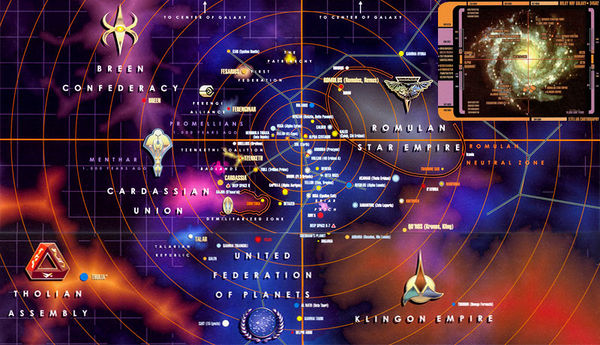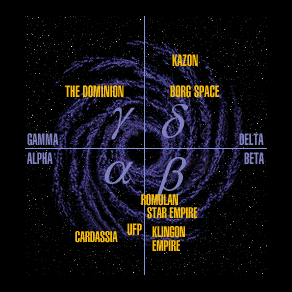Galactic Atlas/Mapping Our Galaxy: Difference between revisions
Jump to navigation
Jump to search
No edit summary |
No edit summary |
||
| Line 1: | Line 1: | ||
{{atlas|quadrants}} | {{atlas|quadrants}} | ||
==Quadrants== | |||
Our galaxy is divided into four '''quadrants''', defined by one meridian passing through the galactic core and the [[Earth|Sol system]] and a second one perpendicular to the first, that also passes through the galactic core. | Our galaxy is divided into four '''quadrants''', defined by one meridian passing through the galactic core and the [[Earth|Sol system]] and a second one perpendicular to the first, that also passes through the galactic core. | ||
| Line 9: | Line 10: | ||
*[[Delta Quadrant]] | *[[Delta Quadrant]] | ||
The [[United Federation of Planets]] and its neighboring powers are located in the | ==Local Space== | ||
[[File:Alpha-beta-quadrants.jpg|center|thumb|600px|The [[United Federation of Planets]] and its neighboring powers are located in the [[Alpha Quadrant]] and [[Beta Quadrant]].]] | |||
==Sectors== | |||
A '''sector''' is a much smaller volume of space measuring 20 cubic lightyears. Sectors typically contain several stars and are consecutively numbered; some also have a label, normally, but not always, named after an important star system in that sector. | A '''sector''' is a much smaller volume of space measuring 20 cubic lightyears. Sectors typically contain several stars and are consecutively numbered; some also have a label, normally, but not always, named after an important star system in that sector. | ||
Revision as of 00:53, 15 November 2015
| Stellar Cartography |
|---|
| Galactic Atlas • Campaign Regions • Spatial Regions • Star Systems • Nebulae • Star Charts |
QuadrantsOur galaxy is divided into four quadrants, defined by one meridian passing through the galactic core and the Sol system and a second one perpendicular to the first, that also passes through the galactic core. Local Space The United Federation of Planets and its neighboring powers are located in the Alpha Quadrant and Beta Quadrant. SectorsA sector is a much smaller volume of space measuring 20 cubic lightyears. Sectors typically contain several stars and are consecutively numbered; some also have a label, normally, but not always, named after an important star system in that sector. |


